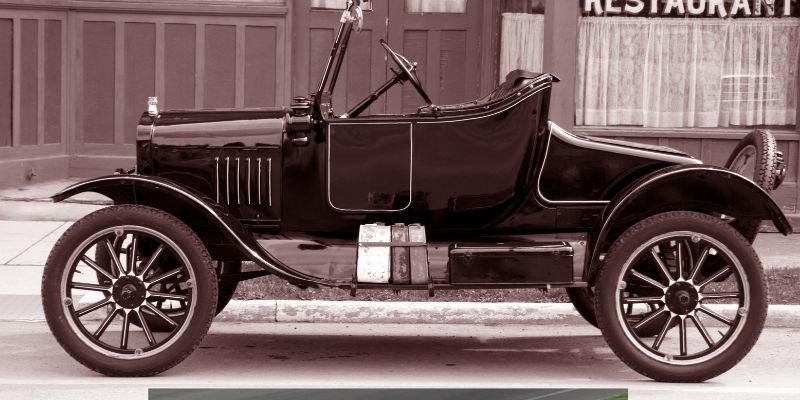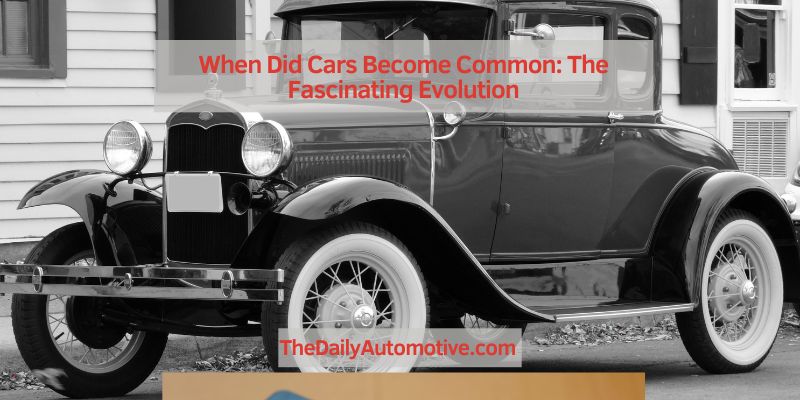When Did Cars Become Common: The Fascinating Evolution
Cars became common in the early 20th century. The mass production of automobiles began around 1910, making them more accessible to the public.
During the early 20th century, the mass production of automobiles revolutionized transportation. This led to the widespread adoption of cars, making them a common sight on the roads. As technology advanced and manufacturing processes improved, cars became more affordable, further contributing to their prevalence.
The convenience and freedom associated with owning a car quickly made them a popular mode of transportation for individuals and families. The increased availability of cars also changed the landscape of cities and towns, impacting everything from urban planning to daily commutes. The emergence of cars as a common form of transportation marked a significant shift in how people moved and interacted with their surroundings.
The Early Beginnings Of Automobiles
Invention Of The First Motor Vehicle
The invention of the first motor vehicle is credited to Karl Benz, who designed and built the first practical automobile powered by an internal combustion engine in 1885. His creation, known as the Benz Patent-Motorwagen, marked a groundbreaking moment in transportation history, laying the foundation for the modern automobile industry. Benz’s pioneering work in automotive technology revolutionized the way people traveled and paved the way for the mass production of automobiles.
The Impact Of The Industrial Revolution On Transportation
The Industrial Revolution, which began in the late 18th century, had a profound impact on transportation and played a pivotal role in the rise of automobiles as a common mode of travel. The advancements in manufacturing, mechanization, and infrastructure development during this period facilitated the emergence of automobile technology. The Industrial Revolution brought about significant improvements in the production of steel, rubber, and other essential materials for automobile construction, making cars more accessible and affordable for the general population. Additionally, the expansion of road networks and the introduction of steam-powered engines set the stage for the transition from horse-drawn carriages to motor vehicles, ultimately contributing to the widespread adoption of cars as a primary means of transportation.

The Transition To Mass Production
In the late 19th and early 20th century, the automotive industry underwent a revolutionary transformation with the transition to mass production, marking the significant moment when cars became common. This shift in manufacturing processes heralded an era of accessibility and affordability, ultimately reshaping the mobility landscape. Explore the pivotal milestones that led to this transition and the impact it had on the automotive industry.
The Introduction Of Assembly Line Manufacturing
One of the key factors in the transition to mass production was the introduction of assembly line manufacturing. This innovative approach to production revolutionized the efficiency of car manufacturing, allowing for a streamlined and accelerated process. Assembly line manufacturing enabled the division of labor, with workers specializing in specific tasks, leading to a significant increase in production capacity and a reduction in overall costs. This shift towards a more systematic and structured manufacturing approach laid the foundation for the mass production of automobiles.
The Role Of Henry Ford And The Model T
Central to this transformative period was the pioneering vision of Henry Ford and the groundbreaking introduction of the Model T. Ford’s implementation of the assembly line technique and his relentless pursuit of innovation played a pivotal role in revolutionizing the automobile industry. The introduction of the Model T, hailed as the “car for the masses,” represented a significant leap towards popularizing car ownership. Through meticulous design and efficient production methods, Ford succeeded in making automobiles more accessible to the general populace, igniting the widespread adoption of cars as a common mode of transportation.
Societal Impact And Adoption
With the invention of the automobile, a significant societal shift occurred, transitioning from reliance on horse-drawn carriages to the more efficient and versatile mode of transportation. The widespread adoption of automobiles revolutionized the way people traveled, transforming both urban and rural landscapes.
Effects On Urban Development And Personal Mobility
The emergence of automobiles greatly influenced urban development and personal mobility, paving the way for unprecedented changes in the fabric of society. Here’s how these advancements impacted the world:
- Urban Planning: The introduction of cars led to the evolution of urban architecture, as cities adapted to accommodate the growing number of vehicles. Road networks expanded, and new infrastructure such as highways and bridges transformed the urban landscape.
- Personal Freedom: Individuals gained the freedom to travel greater distances in shorter time frames, contributing to increased personal mobility and the ability to access new opportunities beyond their immediate surroundings.
- Economic Growth: The ability to transport goods over longer distances expedited trade and commerce, fueling economic growth and expanding markets beyond local boundaries.
Technological Advancements
Technological advancements have played a significant role in the widespread adoption and integration of cars into modern society. As car manufacturers continue to push the boundaries of engineering and innovation, the evolution of automobile technology has transformed the way people travel and shaped the automotive industry. Let’s explore some key developments that have propelled cars into becoming a common mode of transportation.
Innovations In Engine Design And Fuel Efficiency
Engine design has undergone a remarkable transformation over the years, with advancements leading to improved performance, efficiency, and environmental sustainability. The development of powerful yet fuel-efficient engines has not only contributed to enhanced driving experiences but has also addressed concerns about environmental impact. The introduction of hybrid and electric vehicles has further revolutionized the automotive landscape, offering alternatives to traditional gasoline-powered cars. With cutting-edge technology and engineering, engines have become more efficient and eco-friendly, paving the way for the integration of greener transportation options.
Introduction Of Safety Features And Consumer Comfort
The prioritization of safety features has been a key focus for automotive manufacturers, with a range of innovative technologies and systems being integrated into modern vehicles. From advanced airbag systems to collision avoidance technology, the automotive industry has made significant strides in enhancing passenger safety. Moreover, a strong emphasis on consumer comfort has driven the incorporation of luxurious interiors, ergonomic designs, and infotainment systems, providing occupants with a more enjoyable and convenient driving experience. These advancements have not only elevated the standard of comfort but have also set new benchmarks for safety standards across the automotive sector.
Cars In The Modern Era
Modern era cars have revolutionized transportation, shaping the way we travel, commute, and conduct our daily activities. The rapid advancements in technology, the global expansion of the automotive industry, and the emergence of electric vehicles have significantly transformed the modern automotive landscape.
Global Expansion Of The Automotive Industry
The automotive industry has undergone a remarkable global expansion, leading to the widespread availability and accessibility of cars. The advancements in manufacturing processes, global trade agreements, and the development of more efficient distribution networks have facilitated the production and distribution of cars worldwide. This expansion has also led to a heightened competition among automakers, resulting in improved quality and a diverse range of vehicles to cater to different consumer preferences and needs.
The Future Of Automobiles And The Rise Of Electric Vehicles
As technological innovations continue to reshape the automotive industry, the future promises an unparalleled transformation with the rise of electric vehicles. The increasing focus on sustainable and eco-friendly transportation solutions has accelerated the development and adoption of electric vehicles. With advancements in battery technology, charging infrastructure, and government incentives, electric vehicles are poised to play a vital role in reducing carbon emissions and shaping the future of mobility. The integration of artificial intelligence and autonomous features in modern vehicles further reflects the profound impact of technology on the automotive sector, paving the way for more efficient, safe, and connected transportation.

Frequently Asked Questions For When Did Cars Become Common
When Did Cars Become Common?
Cars became common in the early 20th century as mass production techniques advanced, making them more affordable for the general population. By the 1920s, cars had become a common sight on the roads, transforming transportation and society as a whole.
What Led To The Widespread Adoption Of Cars?
The widespread adoption of cars was fueled by technological advancements, mass production techniques pioneered by companies like Ford, and the increasing need for personal transportation as cities expanded and people moved to suburban areas.
How Did Cars Change Society?
The introduction of cars revolutionized society by providing increased mobility, allowing for suburban expansion, changing dating and courtship practices, and sparking a boom in road infrastructure and other related industries.
Conclusion
In the early 20th century, cars became more accessible, leading to their widespread adoption. As people realized the convenience and freedom that cars offered, their popularity grew exponentially. With technological advancements and changes in societal norms, cars quickly became common worldwide, revolutionizing transportation and shaping modern society.









One Comment